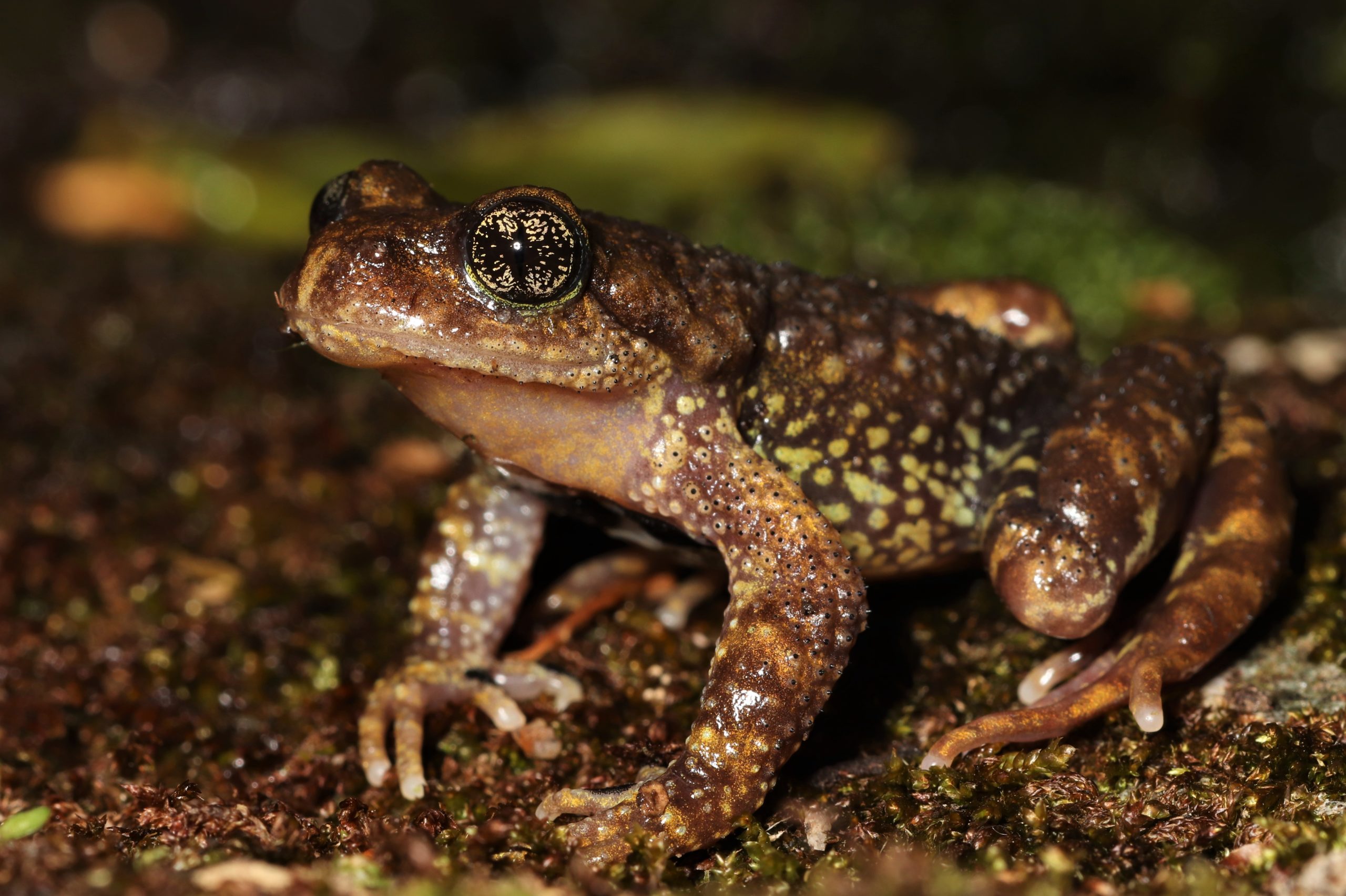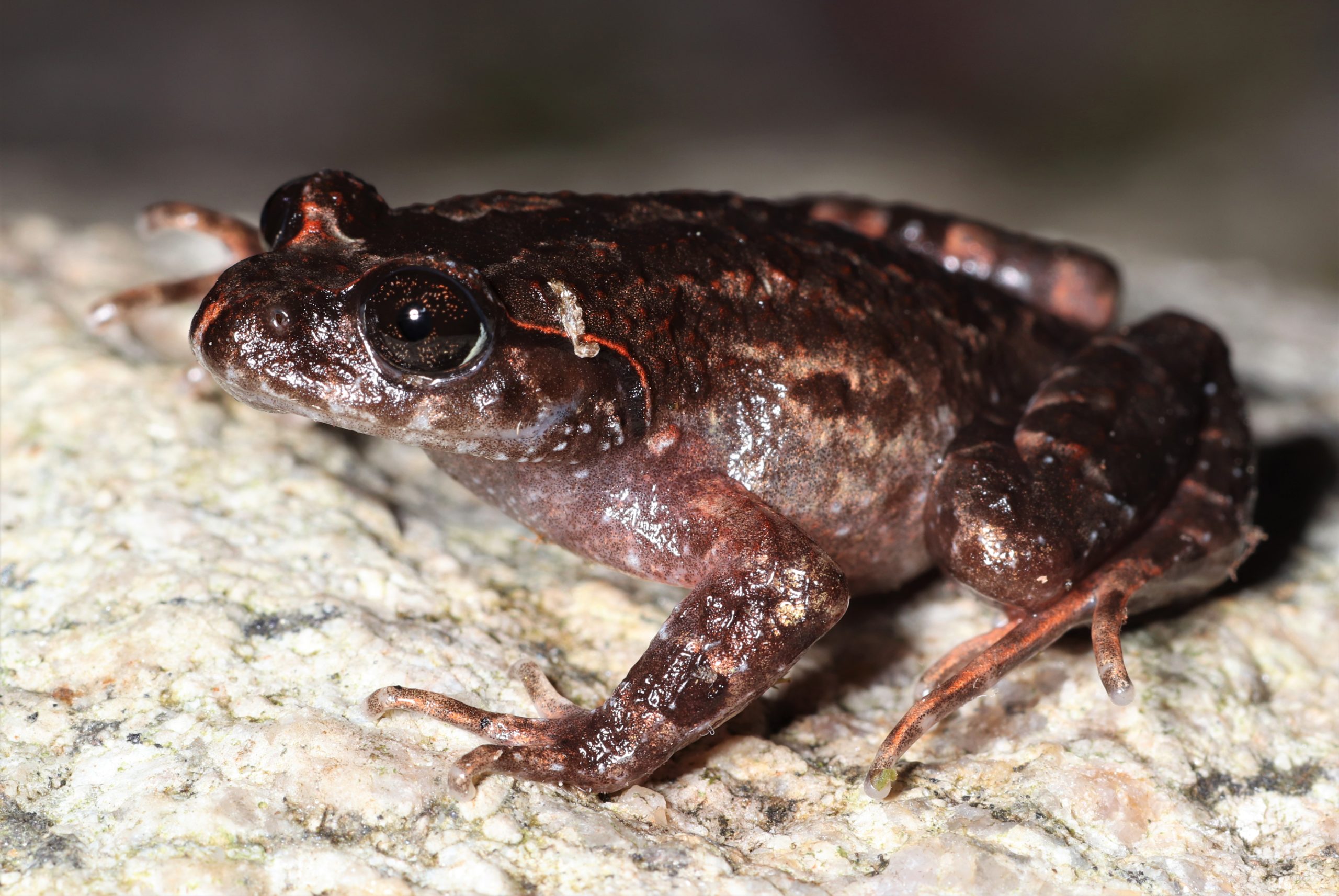World Frog Day is celebrated every 20th March to increase awareness about the plight of threatened frogs and how we can take steps to conserve them. We spoke to Benjamin Tapley from Zoological Society of London and Luan Nguyen from Asian Turtle Program about their work on gathering critical evidence to save two of the most threatened frog species in Viet Nam.
ASAP is proud to have supported the project through the ASAP Species Rapid Action Fund, supported by Fondation Segré. Read about the project here.

1. Could you share your main motivations for starting this project?
Benjamin Tapley (BT): Botsford’s Leaf Litter Frog and Sterling’s Toothed Toad were both described by science in 2013. Botsford’s Leaf Litter Frog was described by one of our collaborators (Dr Jodi Rowley from the Australian Museum). The species descriptions referred to habitat loss at the type locality and a chance meeting with Hoang Lien National Park staff at London Zoo – a ZSL conservation zoo – inspired me to seek funds to gather the data that was needed to assess both species (thankfully Jodi agreed to collaborate!). I wanted to learn more about these frogs before it was too late.
Luan Nguyen (LN): I was shocked when I saw a tiny frog—less than 2 cm—calling under a leaf in 2010 during my first field trip when I was a student. Later I knew that it was an adult frog belonging to a tiny, mystery frog of the genus Leptobrachella. Since that time, these frogs have always been on my mind whenever I went into the forest. When I first met Dr. Benjamin Tapley and Dr. Jodi Rowley in 2015 to talk about conservation work of the Botsford’s Leaf Litter Frog on Viet Nam’s highest mountain on Fansipan, I was so happy and really want to know more about Botsford’s Leaf Litter Frog and other endemic species on Fansipan.
2. Could you describe key findings from the project and why this is important for the conservation of the species?
LN: The main findings of this project included the documentation of oviposition site of Botsford’s Leaf Litter Frog for the first time: the egg laying occurred in soft and wet sand close to a stream, instead of in water, a very specific type of microhabitat. We also managed to conduct a rough estimate of the population sizes of both species (at least in one site). Through this, we realised the difficulties in detecting both species in the field due to their small size and the weather conditions
BT: We already knew that Botsford’s Leaf Litter Frog tadpoles are likely microhabitat specialists from our previous work and the fact that the frogs require different microhabitats for both larval development and breeding could inform conservation management decisions going forward.

3. What are some of the main challenges you and your team have faced in amphibian conservation?
LN: I think one of the main challenges we faced is funding for our conservation work (including fieldwork, salary, and fund for analysis of field data). In addition, many amphibians species are living at very high elevations, and the difficulty to assess sites makes its challenging to collect data and find out more about them.
BT: There are several! One of the fundamental challenges in amphibian conservation is deciding when you know enough about a species to intervene. Many amphibians are incredibly poorly known, even basic information on where a species might occur, how it breeds, the habitat it might need to survive etc., are completely lacking. You could spend years collecting enough information to robustly underpin conservation interventions. However, in the time it takes to gather these critical data, the species may be lost. The second challenge is that of sustainable long-term funding for amphibian conservation. Despite being the most threatened group of animals, amphibian conservation remains woefully underfunded.

4. Sterling’s Toothed Toad Oreolalax sterlingae, which was was included as part of this study, was downlisted from Critically Endangered to Endangered in 2020 and is no longer an ASAP species. Could you share what you consider a success in amphibian conservation?
BT: This is a great outcome for the species and this reassessment was a result of our team discovering a new population of Sterling’s Toothed Toad on a mountain 20 km to the north of the only known site where Sterling’s Toothed Toad was known to occur. This discovery was only possible because our international team had described the tadpole of Sterling’s Toothed Toad a few years previously; and with these descriptions, we were able to observe and identify the tadpoles at the new site. For me, a success in amphibian conservation would be the delivery of long-term, locally lead conservation activities that are having a demonstratable positive impact on the target species or species assemblage.
LN: It is great news that we could extend the distribution area of this species to the north of its previous distribution range. I totally agree with Ben and I believe that without support from conservation funds like ASAP Rapid Action Fund, we could not survey new sites to find new populations.

5. What are some of the ways you engage with local communities and stakeholders to advocate for stronger protection and conservation measures for amphibians?
BT: We have worked with local stakeholders since our project was initiated in 2015. The ASAP RAF-funded work was a direct result of stakeholder engagement. We were asked by local stakeholders to provide evidence that current land use and infrastructural developments were having a negative impact on populations of Sterling’s Toothed Toad and Botsford’s Leaf Litter Frog habitat. Stakeholder workshops have been very effective in getting everyone together to disseminate the latest information and to seek advice on, and support for, next steps.
LN: Yes, in every project period, we always work and collaborate with local stakeholders (e.g., Hoang Lien National Park for this project) to conduct fieldwork, report project results, and discuss about the next steps.
6. In light of World Frog Day, what actions do you think are necessary to protect and conserve threatened amphibian species, and what role can conservation organisations working in landscapes with ASAP amphibians play?
BT: There are lots of actions that are necessary to conserve threatened amphibian species. Habitat loss is probably the primary threat to many amphibian species and many amphibian species do not occur within any protected area. The creation of more well managed protected areas specifically for threatened amphibians would be a very positive action. As mentioned previously, sustainable, long-term funding for amphibian conservation could also be prioritised. It would be fantastic if organisations working in landscapes with ASAP amphibians could be sure that the conservation needs of the amphibians within these landscapes are not forgotten and their plight is also put firmly on the conservation agenda.
- To read the Herpetology Notes publication on Botsford’s Leaf Litter Frog oviposition sites and range extension, click here
- To learn more about the Botsford’s Leaf Litter Frog, click here
- To find out more about Frogs of Fansipan, click here
- To learn more about other ASAP Species Rapid Action Fund supported projects, click here

